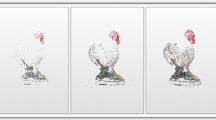Abstract
This paper presents a novel approach to automating the entire coloring process in traditional cel animation production. A feature-based region-matching algorithm is proposed. It first matches a set of master frames to construct correspondences between regions in the master frames and extract a stable topology. The first frame of each scene is then colored based on the set of master frames. With the painted first frame and established stable topology, each region in subsequent frames is matched with regions in the previous frames and colored. Compared with other algorithms, our approach is able to handle bigger changes between frames and automatically color the first frame of each sequence.
Similar content being viewed by others
References
http://www.cambridgeanimation.com/products/animo.htm
http://www.retas.com/
http://www.usanimation.com/
Teh CH, Chin RT (1988) A scale-independent dominant point detection algorithm. In Proceedings CVPR ’88, Computer Society Conference on Computer Vision and Pattern Recognition, pp 229–234
Chang CW, Lee SY (1997) Automatic cel painting in computer-assisted cartoon production using similarity recognition. J Visual Comput Animat 8(3):165–185
Durand CX (1991) The TOON project: requirement for a computerized 2D animation system. ACM Comput Graph 15:285–295
Ablan D (2003) [Digital]Directing – types of shots. http://www.peachpit.com/articles/article.asp?p=31096. New Riders, Indianapolis
Sykora D, Burianek J, Zara J (2004) Unsupervised colorization of black-and-white cartoons. In Proceedings of the 3rd international symposium on non-photorealistic animation and rendering, pp 121–128
Rogers DF (1998) Procedural elements for computer graphics. McGraw-Hill, New York
Catmull E (1978) The problems of computer-assisted animation. In Proceedings of ACM SIGGRAPH, pp 564–569
Arrebola F, Bandera A, Camacho P, Sandoval F (2002) Corner detection by means of contour local vectors. Electron Lett 38(14):699–701
Di Fiore F, Van Reeth F (2002) Employing approximate 3D models to enrich traditional computer assisted animation. In: Proceedings of Computer Animation, pp 183–190
Di Fiore F, Schaeken P, Elens K, Van Reeth F (2001) Automatic in-betweening in computer assisted animation by exploiting 2.5D modeling techniques. In: Proceedings of Computer Animation, pp 192–200
Awcock GW, Thomas R (1996) Applied image processing. McGraw-Hill, Singapore
Li H (2003) Animation techniques, vol 1. Wuhan University of Technology Press, China
Liu H-C, Srinath MD (1992) A string descriptor for matching partial shapes. In Shapiro L, Rosenfeld A (eds) Computer vision and image processing. Academic Press, San Diego, pp 575–592
Seah HS, Chua BC (1994) A skeletal line-joining algorithm. In Insight Through Computer Graphics, Proceedings of Computer Graphics International (CGI’ 94), Melbourne, Australia, pp 62–73
Seah HS, Tian F (2000) Computer-assisted coloring by matching line drawings. Visual Comput 16(5):289–304
Qiu J, Seah HS, Tian F, Chen Q, Konstantin M (2003) Computer-assisted auto coloring by region matching. In Proceedings of the 11th Pacific conference on computer graphics and applications, pp 175–184
Fekete JD, Bizouarn E, Cournarie E, Galas T, Taillefer F (1995) TicTacToon: a paperless system for professional 2D animation. In Proceedings of the 22nd annual conference on computer graphics and interactive techniques, pp 79–90
Madeira JS, Stork A, Grob MH (1996) An approach to computer-supported cartooning. Visual Comput 12:1–17
Patterson JW, Willis PJ (1994) Computer assisted animation: 2D or not 2D? Comput J 37(10):829–839
Gorman LO (1990) k×k thinning. Comput Vis Graph Image Process 51:195–215
Levoy M (1977) A color animation system based on the multiplane technique. ACM Comput Graph 11(2):65–71
Thalmann N M, Thalmann D (1985) Computer animation: theory and practice. Springer, Berlin Heidelberg New York
Haralick MR, Shapiro LG (1993) Computer and robot vision, vol 2. Addison-Wesley, Reading, MA
Litwinowicz PC (1991) Inkwell: a \(2\frac{1}{2}D\) animation system. ACM Comput Graph 25(4):113–122
Milan S, Vaclav H, Roger B (1996) Image processing, analysis and machine vision. Chapman & Hall, London
Smith SM (1995) Edge thinning used in the SUSAN edge detector. Internal Technical Report TR95SMS5, Defence Research Agency, Chertsey, Surrey, UK
Author information
Authors and Affiliations
Corresponding author
Rights and permissions
About this article
Cite this article
Qiu, J., Seah, H., Tian, F. et al. Feature- and region-based auto painting for 2D animation. Visual Comput 21, 928–944 (2005). https://doi.org/10.1007/s00371-005-0307-1
Published:
Issue Date:
DOI: https://doi.org/10.1007/s00371-005-0307-1




